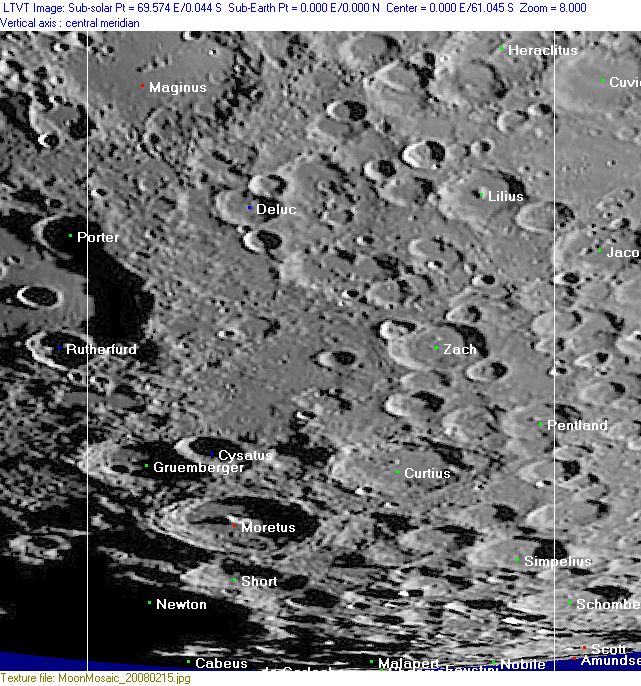Rükl 73
Contents
Rükl Zone 73 - MORETUS
Neighboring maps on the Rükl Nearside Map:
| 73 |
||
Photographic Map
(This map is based on an Earth-based photograph that has been computer-corrected to zero libration. The vertical white lines indicate the left and right boundaries of the Rükl rectangle)
Background image source
See the South Pole page for the appearance of the features in the immediate vicinity of the pole at maximum libration.
Nearside Named Features
- Bonestell (J.Westfall's unofficial name for Cabeus B, see Additional Information below).
- Briggi (Van Langren's disallowed name for Curtius B) (north of Curtius itself, the crater about halfway between Curtius and Zach).
- Cabeus
- Clavius (the eastern part of this well-known large crater is noticeable between craters Porter and Rutherfurd).
- Curtius (J.Hewelcke's Mons Techisandam, together with the IAU's Moretus).
- Cysatus
- de Gerlache
- Deluc (J.Hewelcke's Desertum Evila).
- Desertum Mingui (J.Hewelcke's disallowed name for the southern limb area).
- Faustini
- Gruemberger (J.Hewelcke's Desertum Evila).
- Haworth
- Heraclitus (Van Langren's Croii, together with Licetus on Chart 65).
- Ibn Bajja
- LCROSS (impacted on October 9, 2009, at Cabeus).
- Leibnitz Mountains/ Montes Leibnitz (discontinued IAU names).
- Lilius (Van Langren's Spinola).
- Lilius Alpha (the pronounced central peak of Lilius) (see charts 108 and 109 in the Times Atlas of the Moon, and page 148 in Tony Dethier's Maanmonografieen).
- Luna Incognita (an unofficial name).
- Lunar Prospector (impacted on July 31, 1999, near the moon's southpole) (87.7° South/ 42.1° East).
- Maginus (Van Langren's Leopoldi Arch. Aust.).
- Malapert (Van Langren's Kircheri).
- Malapert Mountain (an unofficial name from M.Robinson?).
- MIP - Moon Impact Probe (impacted on November 14, 2008, very near the moon's southpole; at crater Shackleton).
- Mons Carmaniae (a disallowed name from Le Monnier for a mountain (?) near the southpole, see page 93 (Fig. 59) in E.A.Whitaker's Mapping and Naming the Moon).
- Moretus (J.Hewelcke's Mons Techisandam, together with the IAU's Curtius).
- Mount Clementine (an unofficial name for one of the mountains near the moon's South Pole) (the origin of this name is uncertain, say: obscure).
- Newton (Van Langren's Frederici D. Holsat.).
- Nobile
- Pentland (Van Langren's Wegii).
- Pointers (a nickname from D.Caes for the two bowl-shaped high albedo craters Schomberger G and Simpelius J, at approximately 76 degrees south/ 7 degrees east. Both of them are quite interesting targets during Full Moon because these craters act like "pointers" to get the location of the moon's South Pole. They are a bit like the celestial "pointers" in the well-known asterism Big Dipper of the constellation Ursa Major) (to get the location of Polaris, the northern pole star).
- Pollock (a disallowed name from W.R.Birt for the officially unnamed crater between Deluc and Zach).
- Shackleton
- Shoemaker
- Short
- Simpelius
- South Pole
- Terra Fertilitatis (Riccioli's discontinued name for the whole of Chart 73).
- Terra Photographica (W.R.Birt's disallowed name for the cratered region between Clavius, Deluc, Zach, and Cysatus) (Note: in this region, a possible ancient crater about the size of nearby Clavius was discovered by Y.Goryachko of the Miracle Minsk Imagers. See: LPOD 8-9-2008).
- Vallis Zach-Tannerus (or Vallis Tannerus-Zach) (an unofficial name from D.Caes for some sort of valley-like or chain-like groove north of Zach, running all the way eastward to the south of Tannerus and Asclepi, see Chart 74).
- Zach (Van Langren's Nuti, Riccioli's Arzet).
Farside Named Features
(The following features are not formally included in the present Rükl rectangle, but they are adjacent to it and their centers are less than 10° beyond the mean limb -- so they may be seen here in whole or in part with a favorable libration)
- Luna Incognita (an unofficial name).
- Southpole-Aitken Basin (an unofficial name) (only the most southern part of it could be observed, this during favorable libration).
- Slater
- Sverdrup
- Wiechert
Lettered Crater Locations
(click on the thumbnails to view full-sized images; use browser BACK button to return to this page)
Full zone with lettered craters
Lettered craters by quadrants
(the dashed white lines are the centerlines of the Rükl zones)
| North West |
North East |
| South West |
South East |
Additional Information
- Other online descriptions of features in this Rükl map section:
John Westfall's Bonestell (Cabeus B)
- John Westfall proposed calling Cabeus B, at 82.4° south/ 53.0° west, Bonestell (see: the south pole map on page 67 of the article Exploring the Moon's South Pole, by Alan M. MacRobert). Chesley Bonestell was one of the most important pioneers of Space Art, and was also one of the contributors to the legendary illustrated spaceflight articles by Wernher von Braun and Willy Ley in Collier's magazine. Westfall's suggestion was not adopted by the IAU, however Bonestell is honored by an IAU-named crater on Mars.





